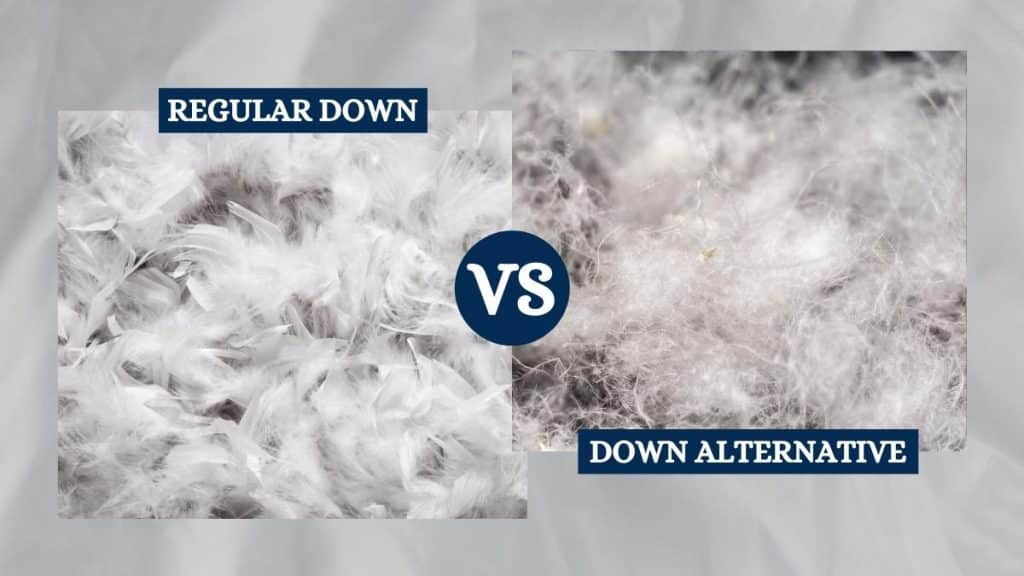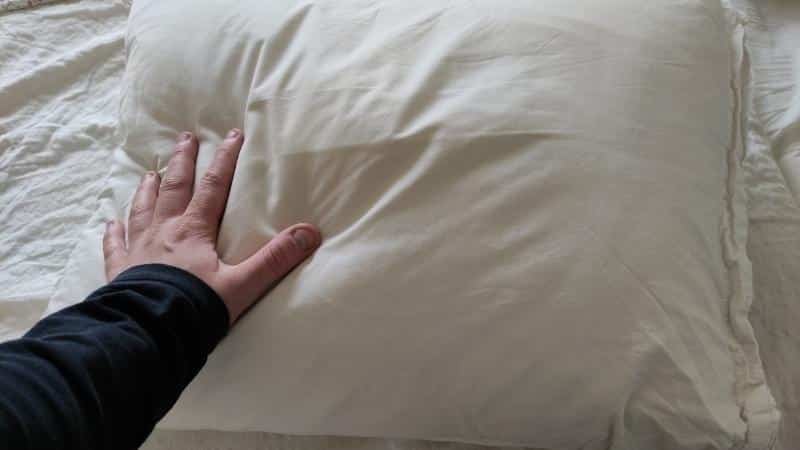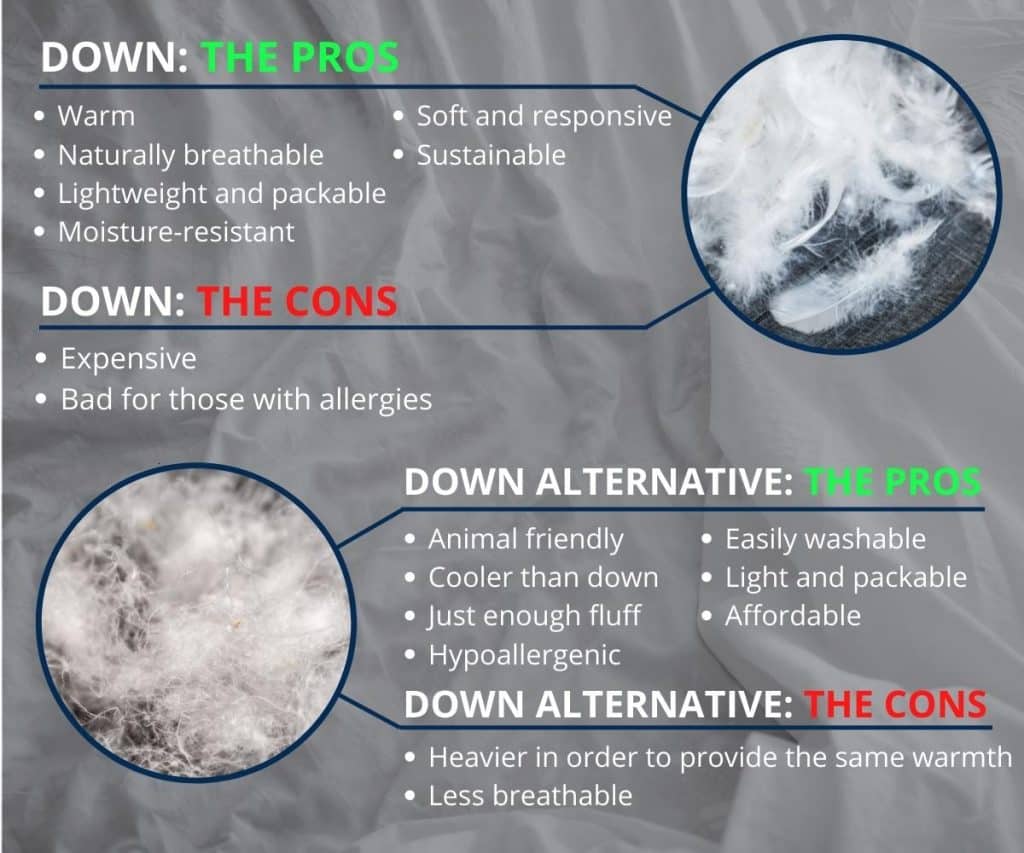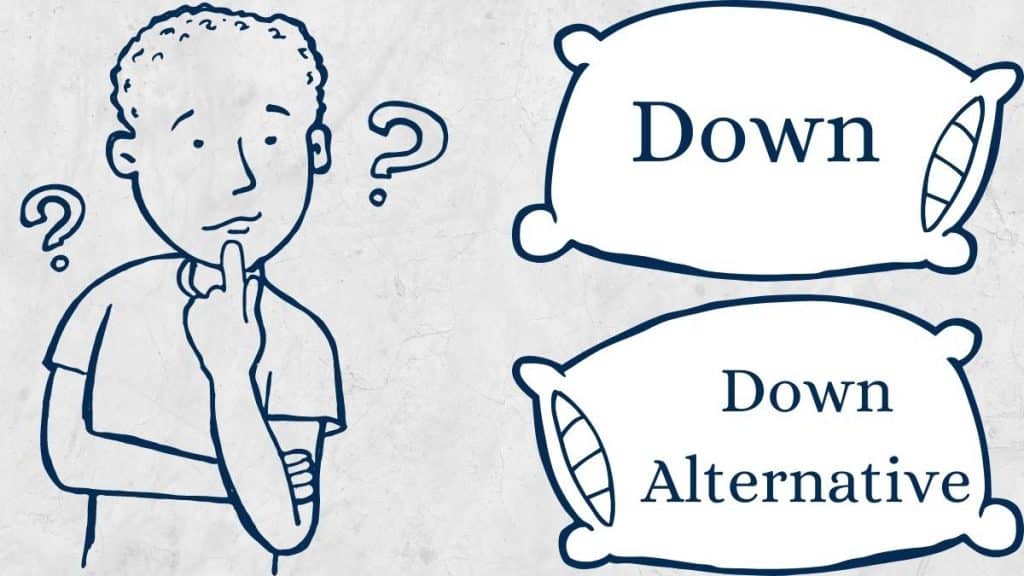Are you in the market for a new pillow?
Perhaps you’ve decided to settle for a down pillow. But as you do some research you find that you can choose between regular down and something called down alternative.
So, you’re wondering, what’s the differences between these two and which should I end up picking?
The main difference between down and down alternative pillows is the filling used. Down is obtained from the soft undercoat of ducks and geese, while down alternatives are constructed from a synthetic polyester material that has a natural softness like that of traditional down.
Ok so essentially down comes from birds and is a natural material, while down alternative is a synthetically made material.
But, which will work the best for you? Well, that’s what you will find out in this post.
Read on to learn more about these two very similar, yet different materials, their differences, pros and cons, and ultimately which one you should pick depending on your needs and desires.

What is Down?
Down is a filling feather collected from the undercoat of geese, ducks, and swans and is popular due to its incredible softness.
Because down is gotten from birds, confirm if it is ethically sourced and authorized by the Responsible Down Standard (RDS).
What is Down Alternative?
As stated earlier, down alternative is a synthetic type of down. But what is an alternative down fill made of? This advanced material is usually constructed with a polyester microfiber fill that looks and feels very similar to regular down.
Down alternative doesn’t use animal-sourced materials making it an excellent choice for people who are allergic to down or don’t want to use animal products, but are looking for a pillow with a lush loft.
Differences Between Down And Down Alternative Pillows
Though down and down alternative pillows may appear similar on the outside, they differ in various ways. Let’s look at how both types are built, how they feel, and how they perform.
Fill
The obvious main distinction between down and down alternative pillows is the filling used. Again, as stated earlier, down pillows, as the name implies, are filled with down, a natural material from ducks or geese.
Down alternatives use either synthetic fill like polyester and occasionally regular cotton, or as a mixture of both.
Durability
Down fill is more long-lasting than fill found in down alternative pillows. As a result, down pillows typically last longer than down alternative pillows.
Warmth and Breathability
Down pillows are usually warmer than down alternative pillows due to their extra loft and fill power.
Down alternative pillows can be warm as well, but they need extra fill to be as warm as down pillows. As a result, it is uncommon to find an alternative down pillow that is both light and warm.
Down alternative pillows are also less breathable than the fill found in down pillows. Since it expands less, there is less room for air to circulate through the pillow, exposing sleepers to overheating and waking up hot and sweaty at night. When sleeping on a down pillow, this is not likely to happen.
In essence, natural down pillows can be both warm and breathable at the same time, they can even be cool if the climate is hot because of their temperature regulating properties. Down alternative doesn’t have these same properites.
Fluff

When people think of a pillow, they may think of something fluffy and cloud-like. In general, down pillows are fluffier than down alternative pillows and rise higher off the mattress.
This is due to the fact that down fill typically has more “fill power” than down alternative fill. This implies that a small piece of down expands and occupies more space than the same piece of down alternative.
Furthermore, though some alternative down pillows are advertised with a specific fill power, this is not always the case. The fill power of a down-alternative fill is hard to determine. Anything between 550 and 750 fill power is good for a down pillow, and anything above 750 is excellent.
Cleaning
In general, down alternative pillows are much easier to clean. This is due to the fact that they can usually be thrown in the washing machine and dryer at home for quick cleaning and drying.
Down pillows on the other hand, are much more difficult to care for because they must be taken to a dry cleaner or a Laundromat for proper cleaning. The majority of down pillows cannot be cleaned at home.
That is why, when using a down pillow, we recommend using a pillowcase. If something is going to stain or become dirty, it’s much better that it be the pillowcase and not the pillow itself. When using a down alternative pillow, pillowcases are also a good idea since they are easier to clean than the fill.
Allergies
One of the main disadvantages of down is that it attracts allergens such as dust mites and pollen. This can be very uncomfortable for some sleepers and can cause or worsen allergies. While some down pillows claim to have a “down proof” design that prevents these allergic reactions, this is not always true.
On the other hand, down alternative pillows are less likely to trap allergens. They are primarily “hypoallergenic,” making them a better choice for those who suffer from severe allergies.
Price
When choosing between bedding and pillows, price is a major consideration.
Down pillows are generally more expensive than down alternative pillows. With that said, how much you will have to pay for a down pillow depends on the quality of the down and the other materials used in the pillow.
Synthetic materials and cotton used to construct down alternative pillows are less expensive to produce and harvest, whereas down can be more expensive to harvest and process.
Benefits and Drawbacks of Down and Down Alternative Pillows

Benefits of Down Pillows
Warm
Down is thought to be nature’s best insulator. It is made up of millions of interlocking filaments that create air pockets. Warm air is trapped in these pockets, while cold air is kept at bay. As a result, a down pillow provides constant warmth.
Down from larger and more mature geese is commonly used. They have denser and tighter filaments in their feathers, making them fluffier and better insulation.
Naturally breathable
The down fibers allow air to flow freely in and out.
The age of the down determines the filling’s breathability. Younger down is less dense than old down and thus more breathable. However, because of their young and delicate fibers, pillows designed with mature down have a higher insulating capacity and do not collapse or wear down quickly.
Lightweight and packable
Down has an excellent warmth-to-weight ratio. Although a down pillows appears bulky, it is lighter than it appears and more compressible.
Moisture-resistant
Have you ever heard the expression “water off a duck’s back”? Down is responsible for the waterproofing quality…but not body oil! Moisture can be wicked by the filaments of down. As a result, a down pillow keeps you warm and dry.
Soft and responsive
Down has a natural ability to “mold” to your body since it is naturally soft. As a result, a down pillow “hugs” you in complete comfort.
Sustainable
People have used down to make pillows, blankets, quilts, and other fabrics for many years. Because it is compostable and naturally occurring, down is regarded as one of the best sustainable materials. The byproducts of the production of down-filled products are completely biodegradable.
Drawbacks of Down Pillows
- Down pillows are costly.
- The natural material may irritate those with allergies.
Pros of Down Alternative Pillows
Animal friendly
Down alternative pillows are made of non-animal products. That is, no animals are killed or harmed in making the bedding.
If you’re a pet owner or an advocate for animal rights and welfare, you’ll be happy to know that nothing alive was killed in the process of creating something solely for human comfort.
Cooler
Due to its exceptional insulation, a down pillow does provide excellent warmth. But what if you don’t need a pillow that is too warm? What if you reside in a humid environment, such as Florida? What if there is a blackout and your air conditioner fails to function? It will be hell on earth to lay your head on a down pillow on a warm night.
If you prefer a cooler night’s sleep, a down alternative is ideal. The fibers do not attract a lot of warm air, even though it still insulates well and offers warmth. This is great for a better, more comfortable night’s sleep in warmer climates.
Just enough fluff
Oh, how we adore the sensation of snoozing in the clouds. A down pillow gives you that lovely feeling with its thick fluff. However, being swaddled in too much thick fluff can make you feel as if you’re being suffocated. This is especially true—and sometimes irritating—if you have a bed partner who enjoys cuddling you.
Good news, a down alternative pillow still provides a nice amount of fluff, but not to a devastating extent. Sleeping is still enjoyable though not cloying.
A bigger variety of exterior fabrics
Since down alternative pillows are made mainly from synthetic fillings, they are more compatible with a wider range of fabrics that make up the pillow’s outer covering.
As a result, you can buy a pillow with an outer covering made of Tencel, polyester, fleece, and other natural and synthetic fabrics, each with its texture, degree of softness, feel, and other characteristics.
To complement the natural filling, down pillows typically use natural materials such as silk or luxury cotton as outer coverings.
Hypoallergenic
Down is a natural fibrous material that attracts bugs and allergens. All birds preen because they use their beaks to remove parasites from their feathers. If you have an allergy, sleeping on an allergen-rich down pillow will trigger your sneezing, coughing, and itchy skin.
In general, down alternative pillows are hypoallergenic. They do not attract pollen, dust mites, dust, or other allergens that can cause or aggravate allergies.
Easily washable
Down alternative pillows are simple to clean and care for. How do you clean an alternative pillow? Simple! Machine-wash at home with warm water and dish detergent. It can then be easily dried; simply air dry it, and you’re done.
For a down pillow it’s a different story. Because of the unique properties of down, the pillow must be taken to a dry cleaner for proper cleaning. In general, a down pillow cannot be washed at home without special chemicals and processes.
Light and packable
To compensate for fluffiness, down alternative pillows may have more filling. However, this does not imply that they are heavy.
In fact, most non-down pillows are full of high-tech polyester or cotton fillings that allow them to be packaged while remaining lightweight.
Affordable
Making a down pillow is expensive because of the time and effort required to harvest the feathers of ducks or geese. When you consider the cost of running a duck or goose farm, it’s easy to see why down pillows are so expensive.
Why are down alternative pillows less expensive? Synthetic materials used in the filling are easy to produce and harvest, hence fairly inexpensive. As a result, if you’re looking for a low-cost pillow, a down alternative is the way to go.
Cons of Down Alternative Pillows
- Because more fill is required, down alternative pillows has to become heavier in order to provide the same warmth.
- Since synthetic materials are less breathable, down alternative pillows are less comfortable for “hot sleepers.”
Which to Pick Depending on Personal Needs: Down or Down Alternative Pillow?

How can you choose between a down and down alternative pillow now that you know what each bedding option offers?
We’ve created a simple comparison based on five factors: comfort, allergen sensitivity, care, durability, and price.
1. Comfort
Down is the way to go if you want the fluffiest and coziest pillow. Down fill bedding has a cloud-like feel and appearance due to the material’s ability to trap air.
Down’s breathability also provides room for better air movement, which helps to keep you cool while you sleep. Down is a better option if you always sweat or “sleep hot.”
Due to its ability to trap air, down bedding needs less fiber material to provide warmth and fluffiness, making it lighter than down alternatives.
2. Allergen Sensitivity
It doesn’t matter how comfortable your bedding is; if you’re coughing and wheezing all night, then it is useless. For people with severe allergies, the down alternative is the ideal option.
Down’s natural material seems to attract dust and pollen in its air pockets, irritating those who suffer from severe allergies.
Down alternative’s hypoallergenic fill allows you to enjoy the same experience down without irritations.
However, you can reduce your exposure to allergen irritants by covering your bedding with a tightly woven protector.
3. Care
Down alternative pillows can be washed at home, making them a carefree product.
Special care must be taken to ensure the longevity and comfort of down products. Dry cleaning is usually recommended.
However, washing down alternative bedding on a regular basis may result in a faster breakdown of the fill material or outer shell.
It is recommended to use a washable pillowcase to protect your pillow as it reduces wear and tear from washing it. Proper care will extend the life of both down and down alternative pillows.
4. Durability
Because down is a more long-lasting material than synthetic fill used in down alternatives, down pillows will typically last longer.
Due to its durability, down has been used for generations. A down filled pillow can last for almost a decade if well cared for.
5. Price
Since it is made from a natural material, down is more expensive to obtain. Down alternatives, with their synthetic fill, are normally less expensive.
Frequently Asked Questions
Which is Considered Better: A Down or Down Alternative Pillow?
While down and down alternative pillows are relatively similar overall, there are four main differentiators that will make people consider one to be better than the other, these four are; comfort level, temperature control, allergy considerations and price.
So for instance, if you want a pillow that is soft and comfortable, has great temperature control, you don’t have any allergies, and you don’t care about the cost, then a down pillow is definitely better for you.
Contrarily, if you’re on a tight budget and care a lot about the cost, maybe you have dust mite allergy, and temperature control isn’t as important to you, then a down alternative pillow will be a better choice for you.
Which is Softer: Down or Down Alternative?
As stated earlier, down is softer than down alternative because it has a higher fill power. Down traps air better than synthetic down alternative making it ver soft and comfortable.
Which Last The Longest: A Down or Down Alternative Pillow?
Down fill is more long-lasting than fill used in down alternative pillows. As a result, down pillows are typically more durable than down alternative pillows.
What is More Sustainable: Down or Down Alternative?
That’s like asking between an apple and an orange which fruit is better. Each type of pillow has unique benefits and drawbacks as discussed earlier. The best answer is that, on a personal level it depends on your choice and needs.
For instance, if you have allergies, you should opt for a down alternative pillow. If you reside in a cold environment and prefer warmer sleeping conditions, a down pillow is excellent.
On an environmental level however, natural down is more sustainable as the byproducts of the production of down-filled products are completely biodegradable. Polyester materials used to make down alternative on the other hand is not environmentally sustainable as it’s a sort of plastic.
Which is Better For Throw Pillows: Down or Down Alternative?
I recommend down alternative pillow inserts since they do not contain down allergens, which is good if you have guests over that may have allergies.
Down alternative pillows are not rigid (like true polyester, which is very commonly used in throw pillows) and do not completely flatten when laid on with your whole body weight like down would, not to mention that no little feathers are poking you in the head or back. Down alternative inserts are soft enough to allow you to do the karate chop as well!
The Bottom Line
There is some back-and-forth between down and down alternative pillows. Each has its own set of benefits, drawbacks, and quirks. Do you want something thick and warm? Down is the right option.
Are you looking for something hypoallergenic and low-cost? There are numerous down alternatives available.
